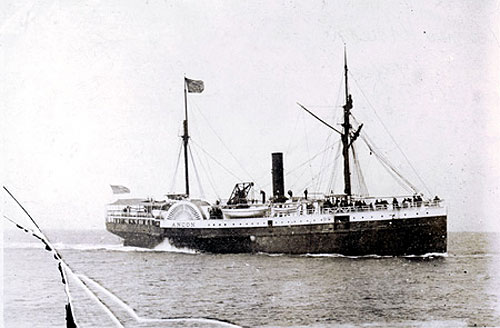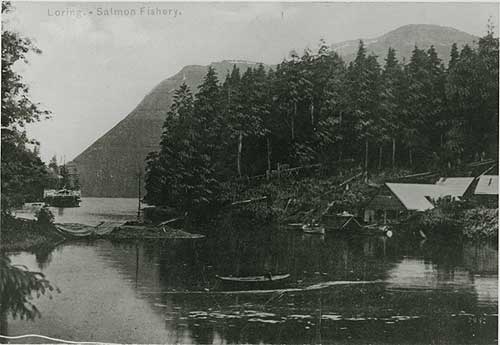 A Famous Artist Runs Aground In Loring By DAVE KIFFER February 13, 2007
The Ancon which had been built in New York in 1867, according to Alaska maritime historian Doug Charles, and purchased by San Francisco based Pacific Coast Steamship Co. in 1876. It had previously made some local history when it delivered the Rev. William Duncan to his new community of Metlakatla on Annette Island in 1886. The Ancon had been making the Alaska run since 1882.  Donor: Bertha Hunt Wells, Tongass Historical Society Photograph courtesy Ketchikan Museums
The Ancon had left Port Townsend, Washington on August 12 on its regular, nearly three week long run that it undertook several times each summer up the Inside Passage. It stopped at salmon canneries and salteries as well as the major settlements along the way. The ship also took a side trip into Glacier Bay which was still half covered by glaciers in those days. It spent several hours in Loring. At 3 a.m. on the 29th, the ship cast off. "On the wharf a Chinaman, one of the cannery hands, was casting the lines," Historian Pat Roppel wrote in the Alaska Journal. "He did not understand when Captain (H.H.) Lloyd called out to keep the stern lines secure so the ship could swing around on them as she left the wharf. A stiff wind was blowing and when the cannery hand let the stern lines go, the men at the wheel could not keep the ship in the narrow waterway. The Ancon drifted hard onto a reef that was (only) a few feet out from shore." The rock pierced the hull of the 226-foot ship and water poured in. The 200 passengers and crew were evacuated in the middle of a driving rainstorm. Most were given shelter inside the cannery building, although some of the women passengers stayed in the superintendent's house and some of the men bunked with the Native fishermen who had two dozen cabins around cannery and wharf, according to Roppel. Roppel wrote: "(passenger) Ben Kramer of Lakeport, Indiana described Loring this way: 'This place is nothing but a fishing camp. It contains a salmon cannery and about 100 white men who work about it during the season, but not one solitary white woman. About two dozen cabins, with the cannery and the wharf, compose the village.'" Among the visitors forced to seek refuge in tiny Loring were the Governor of Colorado, William "Billy" Adams and his family and a young man from a politically prominent New York family, Benjamin Fairchild. The visitors initially expected to have to wait in Loring for at least a week for word of the disaster to get South and a ship to be sent to pick them up. But the next day the Pacific Coast Steamship Company vessel George W. Elder (which later gained fame as the vessel the 1899 Harriman Scientific Expedition used to Alaska), arrived on its regular run and its dcrew offered to immediately take the stranded passengers south. Once the Elder departed, crews salvaged as much of the canned salmon and other cargo as they could. Most of the wood from the ship was later used to build cabins and repair the cannery and wharf. The Ancon was left to break up on the rocks. Today you can still see the remains of its boilers at low tide off Loring.  Donor: Sixten Johanson, Tongass Historical Society Photograph courtesy Ketchikan Museums
The Ancon painting features the strong, expressive imagery of much of Bierstadt's works, but with little of the "shining glory" he often portrayed. Apparently viewed at dusk, much of the canvas is taken up by the grey water and the somewhat ominous great clouds along the horizon and above the listing ship. A thin point of land reaches out to the ship, mirroring the shore of the rest of Revillagigedo Island in the distance. The only bright color in the photo is some late in the day sunlight on the yellowish sidewheels. The tone of the picture clearly indicates that the future of the ship is not promising. The Ancon is listing toward a break in the clouds in the distance, but help will not be coming for the stricken ship. Albert Bierstadt was born in Germany in 1930, but his family emigrated to the United States when he was still a toddler. By the time he was in his early 20s he was already teaching painting and had taken trips to Europe to study the art. In 1859, he made his first trip "out West" with Col. Frederick Lander's military expedition on the Overland Trail. He returned to New York and immediately began translating his rough sketches into soaring canvases that attempted to capture the grandeur and drama of the American West for his eastern audience. "Indeed, because much of the continent remained still relatively unexplored at that time, Bierstadt's monumental renderings of stately mountains and cascading waterfalls created romantic visions of wanderlust in the minds of Easterners," writes Rutgers art University art historian Matthew Baigall, who wrote an artistic biography of Albert Bierstadt. " His first public exhibition of these works in 1860 was a resounding success. Many critics deemed the viewing of his depictions as an almost 'religious' experience, associating his mountain spires with majestic cathedrals, his luminous skies with the awesome power of God." That success was immediately seen in the marketplace where Bierstadt paintings fetched up to $25,000 each, more than had been ever spent on a painting up to that time. Bierstadt made additional trips into the West and Southwest. For a time, he lived in San Francisco but then moved back East because of the illness of his wife. He made additional trips to Europe and in 1889 took a train to British Columbia before heading to Alaska on the Ancon. During his trip, he wrote to his wife he had filled two full books with sketches and make 60 color studies, but only a couple of the studies and neither of the sketch books has survived. The Bierstadt painting is certainly the most famous image of the Ancon aground at Loring, but it is not the only one. Quite a few photographs were taken and at least one other painting was made. Charles Christian Eisele (1854 - 1919) also painted the scene and a copy of his work is in the Alaska State Archives. It focuses on the surroundings of the wreck, showing several cabins on the beach and a large Native canoe nearby. The Ancon is seen on its side at the center of the painting, but is not particularly prominent. The Eisele painting portrays a small boat approaching the stricken Ancon. The background shows a long bay behind the stricken ship but it looks more like the head rather than the mouth of Naha Bay meaning that Eisele perhaps did the painting equivalent of "flipping the negative" in his depiction of the scene in order to make the background more striking. Eisele (who frequently painted as Christian or C. Eisele) was a German itinerant painter who came to the US in 1869. He worked in Utah and Colorado for many years before moving to Oregon toward the end of his life. It's not known if he ever actually visited Alaska. The wreck of the Ancon also had a ripple effect on the opposite side of the continent in the community of Pelham in Westchester County outside of New York City. Benjamin Fairchild was another passenger on the Ancon when it went aground. He would later serve five separate terms in Congress over a 30 year period from the mid 1890s to the mid 1920s, but also have the dubious record of being defeated for re-election each time. Fairchild developed the area called Pelham Heights in the early 1890s when the memory of his Alaskan adventure and the "Ancon" were fresh in his mind. Pelham Heights contains streets named both Loring and Ancon, as well as Elder, which was the ship that came to Loring to rescue the stranded passengers. When it was completed, "The Wreck of the Ancon at Loring Bay, Alaska" was not seen as a major milestone in the life of Bierstadt, he was already famous and the Ancon was much smaller and more monochromatic than his earlier paintings. In the early 1890s, his art was actually in a period of less prominence because his "idealized" realism was seen as somewhat inferior artistically to the Impressionistic work that was coming out of Europe in the 1880s. It was also becoming clear as more Americans were traveling out West that Bierstadt's "spectacular" style was not the reality of the West they thought it was. One of the reasons that Bierstadt went to Alaska was that - like many landscape artists - he saw it was new territory that was still exotic to most Americans having only been purchased from the Russians two decades earlier. The problem was that the medium of photography was becoming a more prominent form of landscape art. Even after returning to New York from Alaska, Bierstadt was unable to generate much interest in his work. He continued to fall out of favor and he eventually declared bankruptcy because none of his new paintings were selling. Bierstadt died in 1902. After his death, his reputation improved dramatically and he is now considered by many to be the foremost American landscape painter of the 19th Century. His image of the Ancon wrecked at Loring, is one of his most popularly re-produced pictures. A quick survey on the Internet shows that you can get the image on posters, reproduced oil paintings, coffee mugs and computer mouse pads among other items. Most art critics consider it somewhat atypical of Bierstadt's work. It is more somber and lacks the soaring grandiosity of most of his earlier paintings. Its relative "bleakness" is now seen as a window into the artist's soul as he watched his popularity wane. The Ancon painting remained unsold at the artist's death in 1902. The Bierstadt estate put it in a gallery in Brooklyn where it remained until 1913 when it was finally sold to collector. It passed through the hands of several collectors until it was purchased by Maxim Karolik, a flamboyant Russian opera star who married an American millionairess and became the "most conspicuous collector of 19th century American art," according to a Time magazine article in 1962. Karolik was a great lover of all things American and almost singlehandedly generated new interest in 19th Century American painting which was out of vogue early in the 20th Century. Time also reported that Karolik said he had almost never paid more than $1,000 for any of the many Bierstadt, Homer and Hassan paintings he acquired. Today, it is not unusual for a Bierstadt painting to bring between $500,000 and $750,000 at auction. One of his idealized "Old Faithful" paintings sold for $665,000 in Santa Fe in December of 2006. Karolik made a deal with the Museum of Fine Arts in Boston that he would give nearly his entire collection to the MFA - some 3,000 items of art and decorative furniture - if it would agree to display large portions of it. In 1945, the MFA received Bierstadt's "Ancon" painting - along with a dozen other Bierstadt works - and continues to display it to this day.
On the Web:
Dave Kiffer is a freelance writer living in Ketchikan, Alaska. Contact Dave at dave@sitnews.us
|